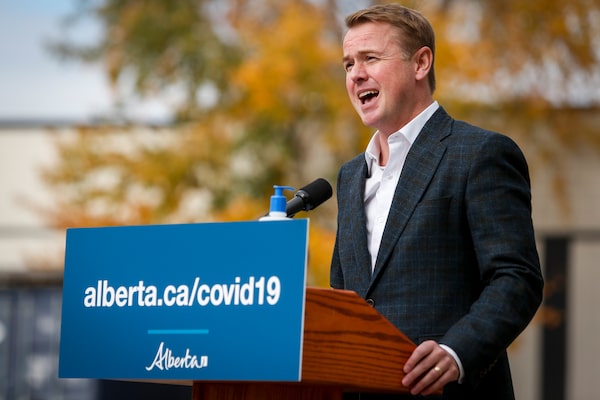
Minister of Health Tyler Shandro speaks during a press conference in Calgary on Oct. 7, 2020.Jeff McIntosh/The Canadian Press
Early this week, Tyler Shandro took the podium with a list of sombre COVID-19 projections for Alberta.
The province’s Health Minister was speaking to the emerging bad news that several SARS-CoV-2 mutations appear to be far more contagious than previous strains of the virus. The variants first identified in United Kingdom and South Africa are present in Alberta and some other provinces – at least in small numbers.
Mr. Shandro said his government’s projections show that new cases could rise to more than 10,000 a day (it currently stands at around 500 a day) within six weeks if the U.K. variant were allowed to spread without public-health restrictions, leading to a skyrocketing number of patients in hospital.
“These new variants present a serious threat and a complicating factor when it comes to relaxing restrictions,” Mr. Shandro told reporters on Monday.
“We need to continue to proceed cautiously, recognizing that our health system is still under significant strain.”
Albertans may have experienced a case of whiplash four days later, when Premier Jason Kenney came out late on Friday with the seemingly incongruous announcement that some of the province’s restrictions will be lifted by Feb. 8.
Based on a decline in hospitalization rates – and other positive indicators such as a decline in active cases – some health measures will be eased for restaurants, indoor fitness and some children’s activities. The Premier also laid out a blueprint for how other restrictions could be eased if hospitalization rates continue to drop in the weeks ahead.
He warned if cases surge again or “if somehow one of these new viral variants takes ahold in our community, and begins to spread in rates seen in some other parts of the world, we will have to impose stronger restrictions again.”
But the decision to ease restrictions came on the same day the federal government announced plans for further travel restrictions. It also came after days of messaging, led by Mr. Shandro and Chief Medical Officer of Health Deena Hinshaw, that emphasized while public health restrictions have been highly effective in stopping the spread of the virus, case numbers remain high.
However, to keep restrictions in place longer goes against the natural political inclination of the Premier, who spent much of last year emphasizing “personal responsibility.” Unlike in some other provinces, he has allowed stores to remain open at 15-per-cent capacity, with the specific aim of trying to save smaller retailers. Deep down, Mr. Kenney’s allegiance lies with the battered gym and restaurant owners who have been calling for a clear timeline for reopening (even as he called out businesses launching mini-rebellions with limited and illegal dine-in openings).
On Friday, he reiterated that Alberta’s economy was in rough shape even before the pandemic. “We recognize the damaging impact that many restrictions have on peoples’ lives. They cause financial stress that often turns into mental and emotional health problems. That’s why Alberta’s government has always regarded restrictions as a last – and limited – policy choice.”
But there are a number of good reasons why the UCP government should be gun-shy about scheduling reopenings now. The virus roared back in the fall in a way that seemed to catch the province off-guard – and the government faced significant criticism from scientists and health care professionals for not bringing in more stringent restrictions more quickly.
And although perceptions of good news have shifted since the start of the pandemic – and though COVID-19 numbers in Alberta are trending in the right direction – the active case counts, hospitalizations and deaths are still much higher than when restrictions were lifted in May and June last year.
Lastly – and most importantly – as the Health Minister laid out, there is vast uncertainty about how dangerous the new variants are. And it’s now clear the schedule for vaccinations is far from certain, and expectations that almost everyone will get two jabs this year are increasingly unlikely.
There is legitimate existential angst from business owners and workers everywhere – but this decision feels rushed. It also comes while the Premier’s leadership is under intense questioning from all sides of the political spectrum – he could badly use a political win. When Mr. Kenney isn’t being hammered from his left for the government’s investment in Keystone XL or opening up new lands for coal development, he’s facing anger from right-of-centre voters – his key supporters – looking for real progress on Alberta’s economic woes, or the easing of COVID-19 restrictions for small business.
In mid-January, the Alberta government did what it was naturally inclined to do, loosening a few restrictions by allowing personal services such as hair salons to reopen, and for people to gather outdoors in small groups. At that time, Mr. Shandro said decisions on “how much further we can ease restrictions depends on our collective efforts over the coming days and weeks to limit the spread of the virus.”
Now the new strains, and the delay to the national vaccination program, should have changed that calculus.
There are no certainties. It might not be as bad as it seems, and the variants might not be as contagious as feared. But the last thing anyone wants is to ease restrictions and then see new cases, hospitalizations and deaths spike again. And politically, no government wants to triumphantly preside over a series of reopenings, just to have to shut it all down again.
We have a weekly Western Canada newsletter written by our B.C. and Alberta bureau chiefs, providing a comprehensive package of the news you need to know about the region and its place in the issues facing Canada. Sign up today.
 Kelly Cryderman
Kelly Cryderman